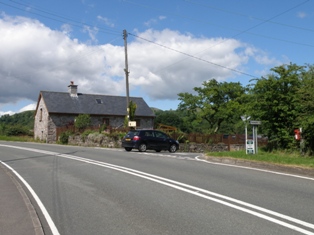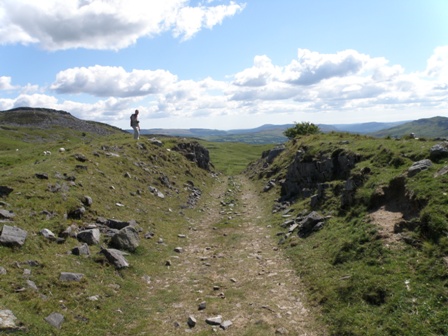Ogof Ffynnon Ddu National Nature Reserve, Powys, East Wales
Designations: part of the Ogof Ffynnon Ddu/Pant Mawr SSSI

A view of Ogof Ffynnon Ddu NNR from the A4067
This National Nature Reserve is best known for its cave system, which is one of the most extensive in Europe. It was discovered by the South Wales Caving Club in 1946, and since then more than 45 kilometres of passages have been explored. There are also some good open paths througout the reserve, and on a clear day the views from the higher points are truly spectacular; however, you will also see fascinating evidence of past industrial activity.
In this are there are the remains of a former firebrick works, including several brickwork kilns, while quarry workings and tramroads are also part of the landscape.
Also on the site is a terrace of houses that were once homes for the families of workers in these enterprises; this building is now the headquarters of the South Wales Caving Club.
Directions
Grid Ref: SN866154
From the M4 at Swansea turn, off at Junction 45 and proceed along the A4067 passing through Ystalyfera, Abercraf and Pen y Cae.
Once through Pen y Cae look out for a right-hand turn towards the village of Penwyllt, and turn down this unmarked road - if you come to Craig y Nos Castle on the right you have gone too far.
Almost immediately after leaving the A4067 you will pass over the River Tawe. After a further 400 metres, at a T-junction on the road, bear left and continue up the hill towards Penwyllt. Pass through the quarry, bearin, right on a deeply rutted road until you come to the large open National nature Reserve car park, which is close to the South Wales Caving Club property. There you will also see interpretation boards on the entrances to various footpaths leading into the reserve.
Below: The turn towards Penwyllt on the A4067

Access
This nature reserve is open access throughout the year. There are two paths on disused railway tracks. The entrance to the lower and more level path is on the right just before entering the car park, and the other path can be accessed a short distance inside the reserve at an entrance beside the South Wales Caving Club buildings. This second track is steeper. There are also a number of other rougher and less clearly defined paths throughout the site. Conditions underfoot can be slippery in winter or during wet weather, and so good walking shoes or boots are essential.
Take great care if you stray off the paths (which is not recommended), because the ground is very rough and uneven and there are deep sink holes throughout the reserve.
Entry to the caves is via locked gates and is not permitted without a pass from the Caving Club.
Below: The views from high up on the reserve are lovely

Facilities
There are no facilities at the site, but there are public toilets at Craig y Nos Country Park and also at the Dan yr Ogof Show Caves NNR, both of which are very close by.
Description of Site
The site consists of large areas of moorland and some small areas of limestone pavement. The views from the higher points of the NNR are magnificent.
Plants you can expect to see on your walks in spring and early summer include Wild Thyme (Thymus polytrichus), Tormentil (Potentilla erecta), Herb Robert (Geranium robertianum), Small Scabious (Scabiosa columbaria), Wood Anemone (Anemone nemorosa) and Lily of the Valley (Convallaria majalis). One of the special alpine flowers to look out for higher up in the reserve where there are exposed fragments of limestone pavement is Mossy Saxifrage (Saxifraga hypnoides).
The moorland is ideal habitat for nesting birds, and we saw Skylarks (Alauda arvensis) and Wheatears (Oenanthe oenanthe) during our last visit at the beginning of July.
Apart from the fascinating geological features, including stalagmites and stalagtites, to be seen at this nature reserve, there are also impressive waterfalls. The caves are also home to bats and many insects, while in the dark underground streams there are small pigment-free crustaceans and also little white blind fish.